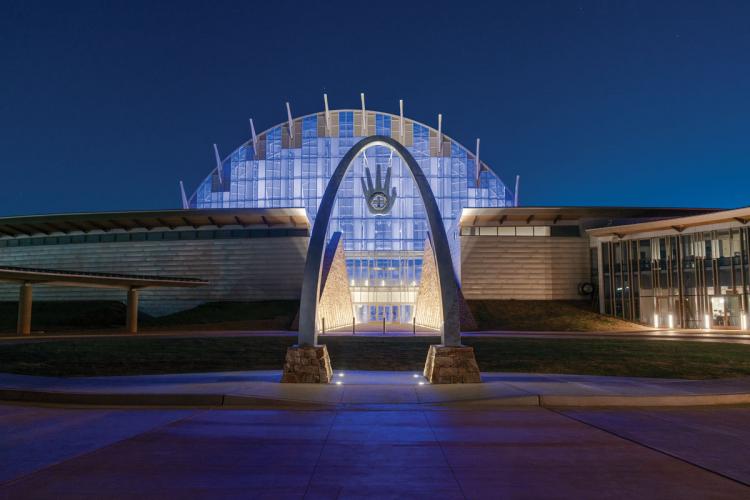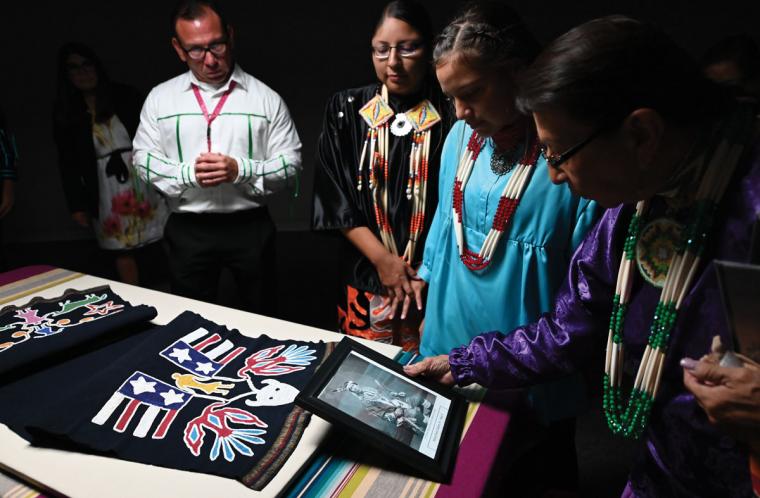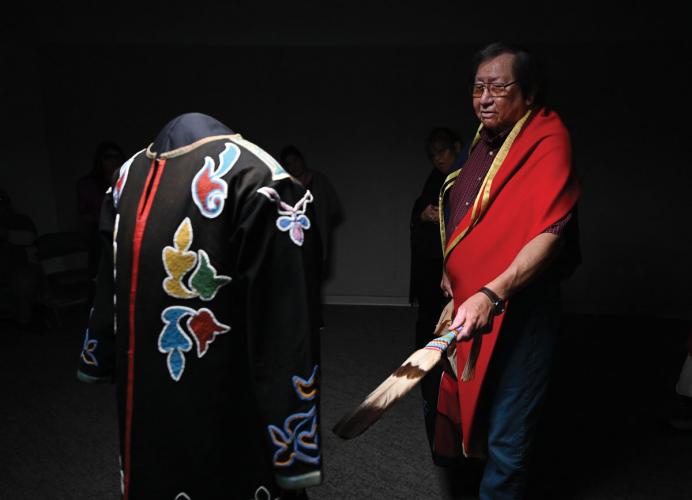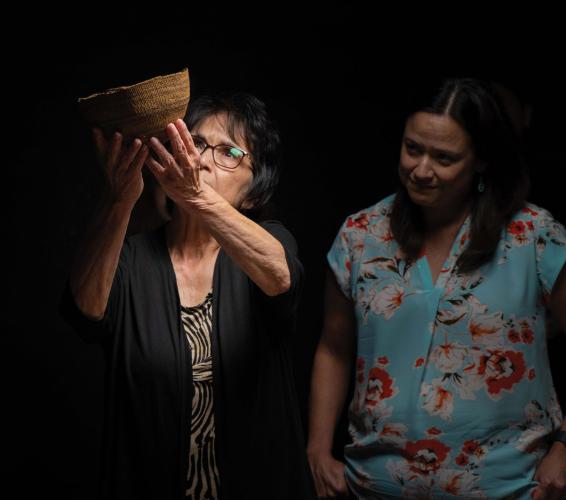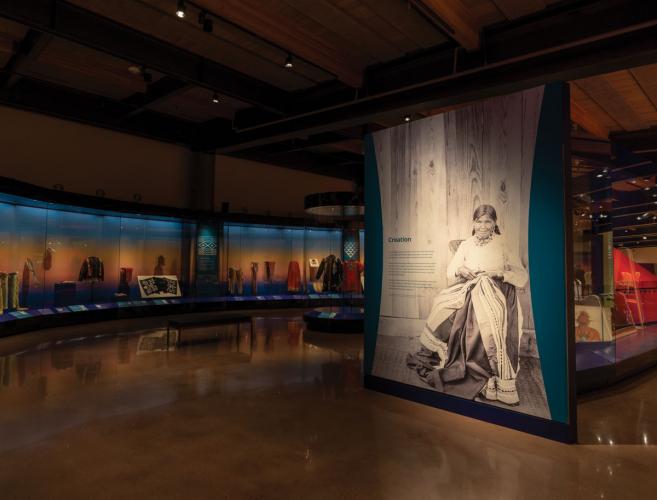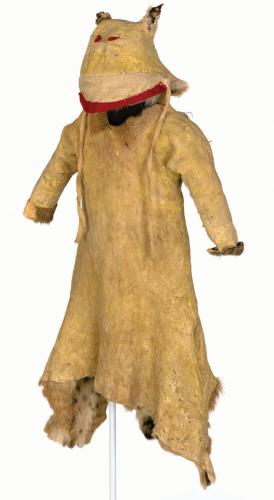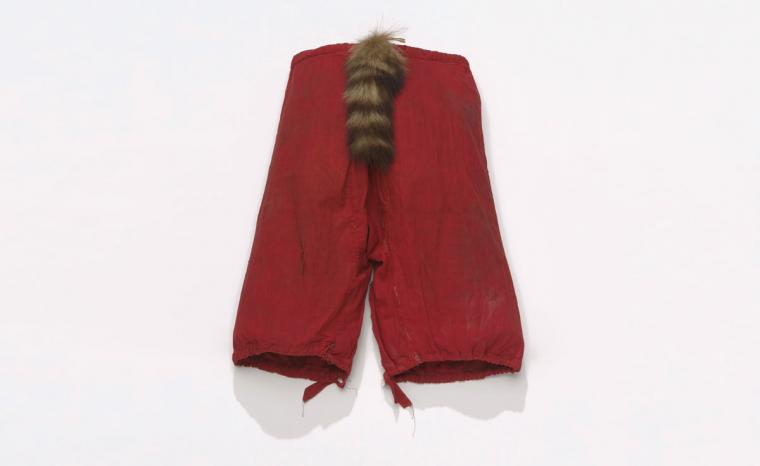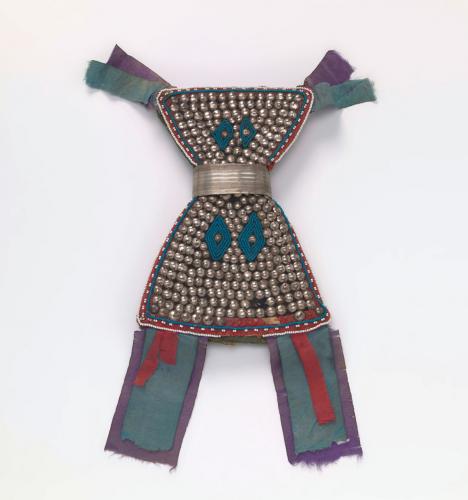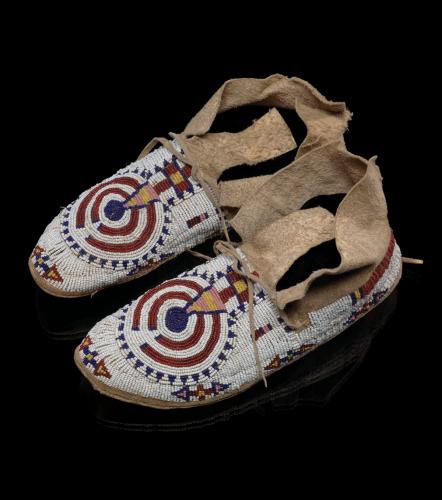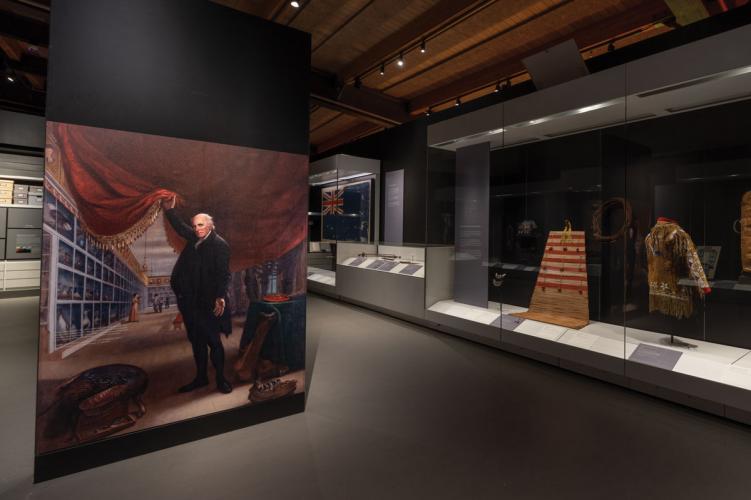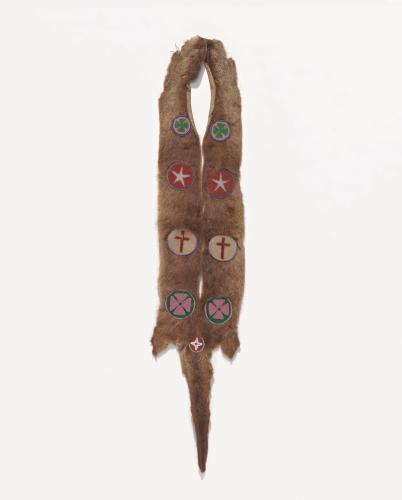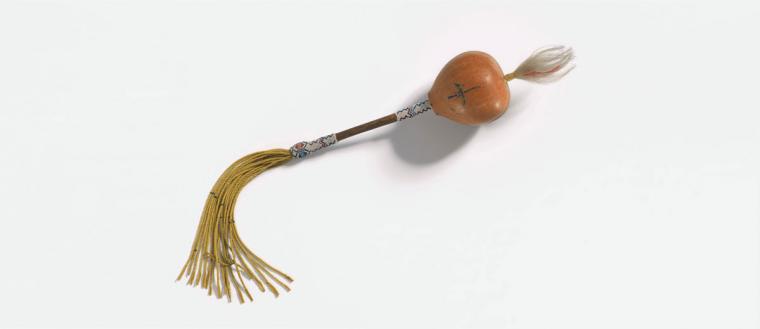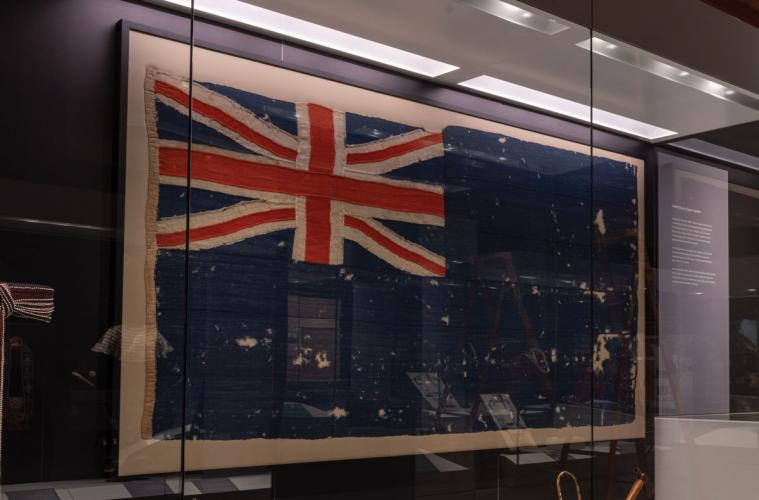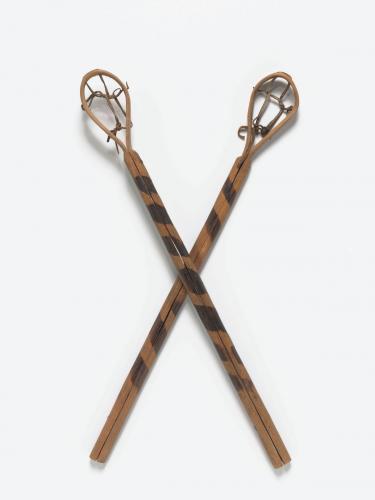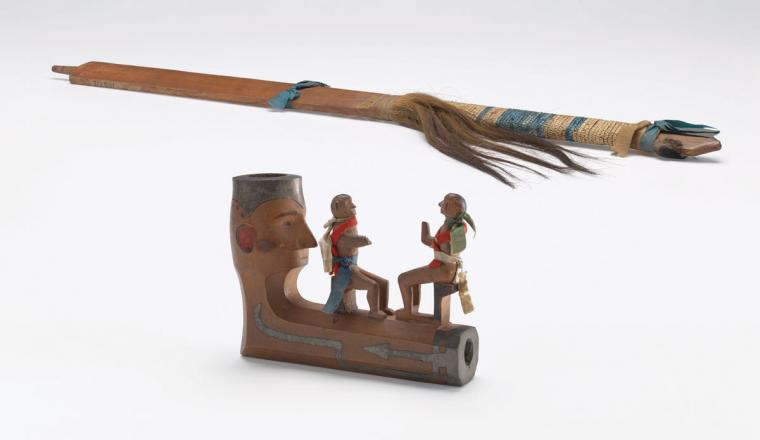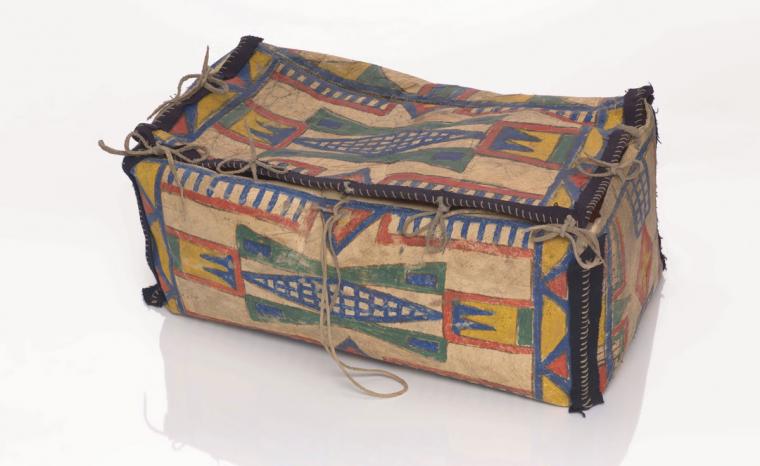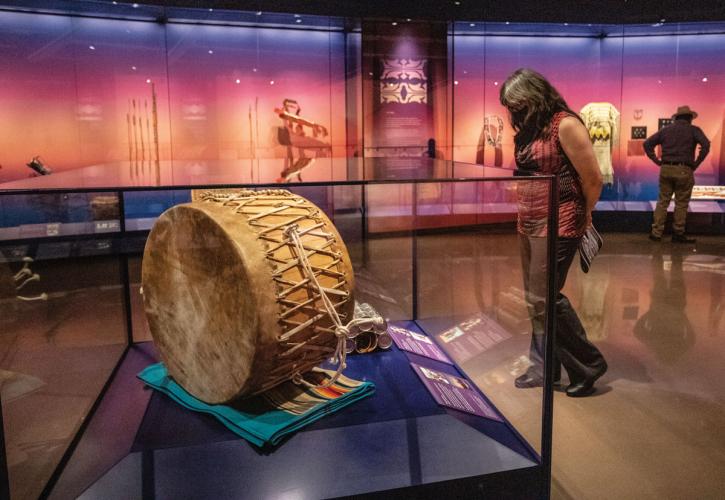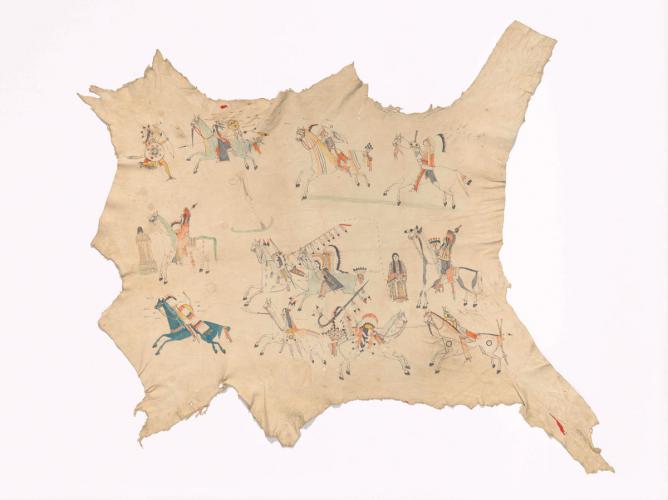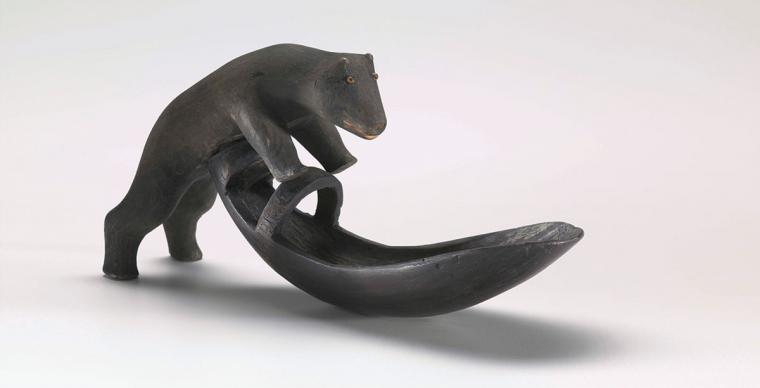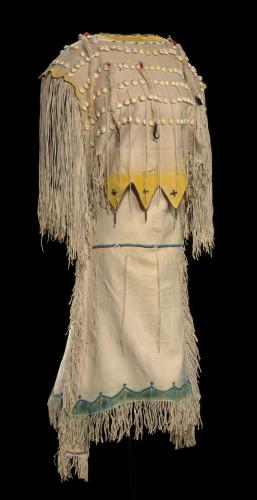“They’re on their way.”
With that announcement from a museum staff member, the room falls silent. The gathered staff and film crew stand still in the darkened room in the newly created First Americans Museum. They are awaiting the arrival of honored guests who were invited there for a unique purpose: to view items of significance to their Native families and communities, objects that had been transported generations ago to a distant museum collection. It’s a reunion more than a century in the making.
Soon silhouettes appear in the doorway, and then the Red Eagle family enters the room, gently stirring the solemn silence as their collective gaze falls on the garment placed on a mannequin in the center of the room. The family, who had traveled nearly 150 miles from the Osage Nation in northeastern Oklahoma, slowly encircle the ornately beaded man’s coat, an object not seen by their family in generations. The reunion of the garment with its family and its Native community is a moment of joy and anticipation: it has so many stories to tell.
Going East
The coat is one of nearly 150 objects from the collection of the National Museum of the American Indian on a 10-year loan to the First Americans Museum (FAM). This is the first museum intentionally built to represent all 39 tribes in Oklahoma. More than a decade in the making, the 175,000-square-foot facility and cultural centerpiece finally opened its doors this September in Oklahoma City.
The FAM exhibition featuring the NMAI collection is titled “WINIKO: Life of an Object,” adopting the moniker from a Caddo word that means the spirit of all things. It looks at how objects reflect values, possess spiritual significance and perpetuate Native traditions. The exhibition features objects from each of Oklahoma’s 39 tribes, including NMAI items dating from about 1906 to the 1930s as well as new pieces that the FAM commissioned.
A few objects, like the coat, were reintroduced to and viewed by representatives of the families or communities from which they came. One was a breech cloth, originally possessed by Benjamin Hollowell of the Iowa Tribe, which was reunited with some of his descendants, including Joyce and Linda Big Soldier. Another was a basket hat owned by Modoc tribal member Martha Lawver, one of 153 prisoners of war removed from her California homelands to the Quapaw Indian Agency in present-day Oklahoma in 1873. Mona Craven and Ramona Rosiere were among those of the Modoc Nation who came to the FAM to meet it. These items, only a small portion of the exhibition, were among the many objects collected more than a century ago for what would become the NMAI collection.
“WINIKO” includes a broad array of every- day items, including stickball sticks, gorgets, shoulder bags, bows and arrows, jars, baskets, feather fans, and pieces of clothing—coats, dresses, belts, hats, leggings, moccasins and breechcloths. The exhibition will initially showcase 114 objects and then rotate through 30 more items across the lifetime of the loan.
The objects’ path to the FAM has been anything but direct. Many of the items had a convoluted route that began in and around the turn of the 20th century. This was a turbulent time when Indian Territory was being culturally and politically stripped down and parceled out to make way for the new state of Oklahoma.
Many of the objects were collected by archeologist Mark Raymond Harrington. He visited numerous tribal communities across the Americas, purchasing items and sending them back East to join the rapidly growing collection of George Gustav Heye, a wealthy banker and son of a petroleum magnate. The collection, which grew beyond the capacity of Heye’s New York apartment and a nearby warehouse, was reorganized in 1908 and most objects were sent to the University of Pennsylvania museum for exhibition and storage.
In 1916, Heye founded the Museum of the American Indian–Heye Foundation, the predecessor of the NMAI in New York City. He deeded the entire collection—then nearly 58,000 objects—to the new institution and served as its director until 1956. The museum’s collection, accumulated across 45 years, now includes more than 800,000 objects.
“He amassed this huge collection,” says James Pepper Henry, executive director of the FAM and the former associate director for community and constituent services at NMAI. “Fortunately for us though, Harrington did a pretty good job of keeping some good records of who he collected these items from.”
The Heye collection was transferred to the Smithsonian in 1989 with the passage of the National Museum of the American Indian Act, a law that established the museums in Washington, D.C. and New York City. Once the objects were within the NMAI collection, they were stored at the Cultural Resources Center (CRC) in Suitland, Maryland. While the objects were cared for in Maryland, there was a concerted effort within the museum administration to find ways to bring them closer to their communities of origin, an effort that began under the leadership of W. Richard (Rick) West Jr. A Southern Cheyenne and founding director of NMAI, West supported a new methodology to dictate how the collections would be managed and interpreted.
“NMAI broke ground by implementing a methodology called shared authority,” says Henry, a Muscogee (Creek) and citizen of the Kaw Nation. “And shared authority was the principle of making sure that Native peoples had an equal say, or the equivalent authority as a curator would have, in terms of developing content and interpreting collections.”
The museum became proactive in pursuing loans to institutions that would get the objects closer to their home communities. Henry was at the table on April 27, 2007, when a memorandum of understanding between NMAI and what was originally the American Indian Cultural Center and Museum (AICCM)—now FAM—was signed in recognition of the relationship between the institutions and to establish areas of cooperation. This included the potential for object loans and exchanges. “It really is special to me, professionally and personally,” Henry says.
Preparing for the Journey
Discussions about a potential loan from NMAI to FAM of objects that had been collected from Oklahoma tribes started in 2012 but began in earnest in 2018, says Rachel Shabica, supervisory registrar for the NMAI. “We started with the true logistics of how are we going to work together to get these pieces back to Oklahoma,” she says. “We started looking at object lists and meeting with the FAM curatorial team.”
The FAM team made several visits to the CRC. First, Welana Queton, co-curator of the “WINIKO” exhibition, spent two years examining the NMAI archives. “The help the NMAI archival staff gave and the amount of records was amazing,” she says. Then FAM staff returned to examine objects, make selections and engage in discussions with the NMAI conservation and registration staff about what they wanted the exhibition to be and how to present it. “So a lot of discussions about is this object something that we can send for a long period of time? How sturdy is it? What kind of conservation work needs to go into it to make it appropriate for a longer-term display? Is there a tribe that needs to be consulted about whether this is an appropriate piece to go on display?,” Shabica says. “It’s a lot of figuring out what the priorities are.”
Erin Minnaugh, the NMAI registration technician hired for the project in 2019, oversaw the preparation and transportation of the loan objects. “There’s a discussion with the curators at NMAI to learn about the history of the object. You want to know any of the display history. Has it been on display before?” she said. “Then that leads into a discussion with the First Americans Museum about how they would like to see it displayed, what the possibilities are. It’s really a conversation between the two institutions.”
Once the objects for the loan were selected, the FAM team researched and established potential connections between the objects and members from several families and tribal communities in Oklahoma. Meetings with those groups were originally planned to be in-person, but the COVID-19 pandemic hit.
“We had to learn how to do that virtually,” which Minnaugh says, “just takes more time.” These sessions revealed stories about the items not found in the records. The consultations provided critical information about how the objects should be cared for culturally and whether they could be displayed or photographed. The sessions also uncovered much about the objects’ histories, leading some to being reunited with their families or communities at FAM.
Fortunately, by the time the objects were ready to be transported to the museum in June, the COVID-19 vaccine was available and NMAI staff could travel again. The objects were carefully packed into crates and shipped by truck from the CRC in Maryland to Oklahoma. A NMAI conservation team as well as Minnaugh were there to greet them. Then the mount makers arrived to help install them into their display cases. “Something like the First Americans Museum, where there’s 114 objects going in that are all very complicated and delicate, doing this virtually was never an option,” Minnaugh says.
Back in Oklahoma
While all the objects arrived safely, even the possibility of their journey back to Oklahoma was often on hold and the completion of the FAM was far from certain for decades.
The state of Oklahoma initiated the creation of the museum as a tourist destination that featured the Native American tribes present before the formation of Oklahoma. “At that time, the state felt it was important to balance that story out, especially with regard to tourism. People coming to Oklahoma are coming to this part of the country looking for that Western heritage experience,” Henry says. “I think the tribes really wanted an opportunity to tell our stories, and to tell those stories from our perspective.”
Kelly Haney, then a state legislator and a former principal chief of the Seminole Nation, was instrumental in the passage of the state bill that established the museum and the Native American Cultural and Educational Authority (NACEA), the entity charged with design, fundraising and construction. But funding woes halted construction for nearly a decade.
A group of tribal leaders, including Chickasaw Nation Governor Bill Anoatubby, approached the state and reached a funding agreement in 2016 that restarted the project. The American Indian Cultural Center Foundation was established to transition management of the museum, and Henry was hired in 2017 as the inaugural CEO of the foundation and museum director.
With construction complete, the museum has become a gleaming showcase of and for the tribes in the region. It features the towering Hall of the People, a nearly 100-foot-tall glass and steel half dome modeled after a traditional grass lodge, easily visible from Interstate-35 and ensconced on the southern bank of the Oklahoma River.
Spiraling from the building is a cosmologically designed earthen mound that pays homage to ancient mound builders. At the base is a tunnel aligned to the sun’s path on the winter solstice, and the peak—overseeing the museum, river and downtown Oklahoma City—is aligned to the summer solstice. Inside, the museum will exhibit Native American history, culture and arts; host educational family and children’s programs; and entertain visitors with culturally inspired Native cuisine and a museum store featuring authentic Native art and crafts.
The Stories Continue
The FAM exhibition that features the NMAI collection, called “WINIKO: Life of an Object,” has three galleries, each focusing on different phases of an object: creation, collection and continuum, meaning how items can help preserve culture. The galleries feature objects from the past century until today and cover topics such as tribal identity, generational memory and the passing on of traditions to future generations. Harrington and objects from his original collection are also featured in the “From Collecting to Decolonization” gallery, which examines the practice of museum collecting and how objects are preserved and displayed.
These objects, made by Native hands, have a life of their own says heather ahtone (who lowercases her name), the senior curator at the FAM. This life is imbued from the person making the object, ahtone (Choctaw/Chickasaw) says, and extends beyond the moment of creation.
“As these objects are carried and gifted from one generation to the next, they carry that life forward, and they become holders of memories and become holders of knowledge. The aesthetics, the materials, all of these things are found within the object,” she says. “Often, museums, from a Eurocentric perspective, have seen objects as being inanimate because they simply weren’t human. And yet, that is the antithesis of an Indigenous approach. And we’re trying to reassert our cultural paradigm when preparing our exhibitions.”
Shabica says that NMAI is just part of a larger journey for these objects, a journey when their identities are made and remade. “It’s important to remember that the perspective of the Native communities in Oklahoma, and everywhere, is frequently that these objects are living things,” she says. “I love the idea that time is cyclical, not linear, for these items.”
For the NMAI to loan these objects to a new venue and place where the descendants of the people that created these objects can be with them is important for those communities, she added. “It’s very moving,” she says. “To know that those objects are continuing their life in a meaningful way.”
“The one thing we were really intrigued by was the fact that we had such good records from Harrington, that we knew the families,” Henry said. “So, thinking of these objects that way, it’s like our family members have been taken away, and they’ve had this journey from Pennsylvania to New York to Washington, D.C. They have stories to tell us. And thinking about bringing them back to Oklahoma and being reunited with their family members, and then having all these wonderful stories to tell while they were gone on this journey.”
“The journey of these objects is not unconnected from the same journey that the people have had. And that removal of our people from our homelands, forcibly taken and placed in a space that is not our own,” ahtone says. “We have had to figure out how to be who we are in a new place. These objects had to do that as they were put into the museum, but now they have an opportunity to reconnect with our communities.”
Edward Red Eagle Jr., a citizen of the Osage Nation, lives in Barnsdall on his family’s original allotment down on Bird Creek in Osage County, Oklahoma. He is a fluent Osage speaker and has served his tribe in several positions throughout his life. He believes the coat he saw and now being exhibited at FAM—based on its color scheme, materials, precise craftsmanship and caretaking—was used for a unique and specific purpose.
“In our tribe, there’s a few very special days. One of them is in our ceremonial drum activity. You take the drum and take care of it. You accept that responsibility,” he said. “They say, ‘You have to pay for that drum.’ They give that to the drumkeeper. He’ll give horses, he’ll give blankets, he’ll give money, he’ll give food, whatever, in the expression of our commitment to that drum, to take care of it. And that gives the whole [community] confidence. On that day, it’s a very special moment. This coat shows that it’s deserving of that particular occasion. This particular coat. It almost certainly was used for that type of purpose.”
For Red Eagle, a family story may confirm the coat’s place in his family and community history. Referring to his great grandfather Paul, he says, “Aunt Mag always said when they paid for the drum for Paul Red Eagle, he came in on a horse wearing a wedding coat. I don’t think it was a wedding coat. I think it was this coat that he was wearing.”
Red Eagle described how his identity and sense of self is derived from his ancestors, and their belongings preserve that. When he sees that his ancestors practiced the same ceremonies that he and his family still practice today, it makes him much more reverent. He recognizes how that connection over time allows his people to live in the non-Indigenous world while not losing their identity.
“It shortens the time period between them and us. We look at it as a century ago, but it’s not that far in the past that they were in the same activity that you’re doing, they’re in the same type of clothes you’re wearing, you’re hearing the same songs,” he said. “That part of the cycle is really beneficial to us individually and us as a people.”
ahtone says that museums should play a pivotal role in not just preservation and conservation but in cultural restoration. This “full authority” includes the reintroduction of objects back to the community, the solicitation of input from family members associated with objects and placement of objects in a manner that is culturally appropriate and relevant to the contemporary Indigenous experience.
“All of our exhibits have been completely designed, all the content has been written, all the research has been done by a completely 100 percent Native curatorial team,” says Henry. “We are taking full authority over the narratives, over the interpretation, over the management of collections associated with our people.”
Before the NMAI and FAM, historically other “museums have not cared about the relationships between these objects and the cultures,” she said. “These objects have been held, in a manner of speaking, as prisoners within these museums. The idea of ownership, the idea of how these objects were expected to stand in the absence of us as people who were predicted to be terminated, extinguished by those same national powers. I have heard people say, ‘we’re still here,’ and the objects are still here, we just need to find a new path.”
“This day had to happen,” Red Eagle said. “We want to take this [story] back to the rest of the family, and we can talk more in confidence about the garment. ‘Guess what you have in this facility—there’s a story.”
“For us to create a space where we can tell our own story against that history? To tell our own story and to bring these objects back into community?” ahtone asked. “To have a space that’s like that, here in Oklahoma. I don’t even know what to expect from it, but I know it’s the right thing to do.”
The First Americans Museum opened September 2021, featuring the exhibitions “WINIKO: Life of an Object” and “Okla Homma, a Tribal Nations Gallery.” For more information, go to famok.org.

